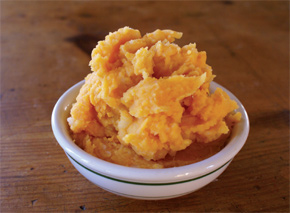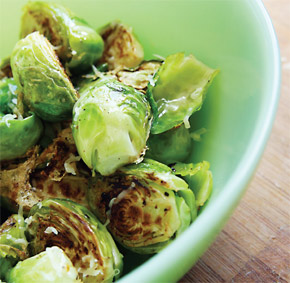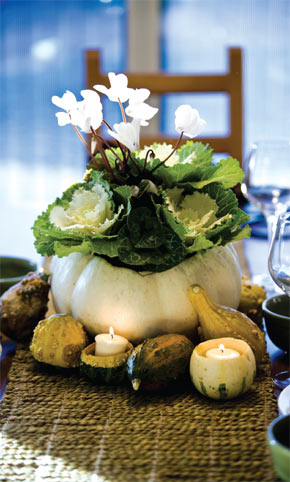Holiday entertaining kicks into high gear this month, as many of us gather for a traditional Thanksgiving feast. Unlike other holidays that drag us into debt, Thanksgiving celebrates the simple basics in life: nourishment, sharing, and gratitude. Preparing a thoughtful meal shows how much you care….about your friends, your family, and California’s bountiful resources.
I prefer to do as much of my Thanksgiving shopping as possible at the farmers’ market—where the food is fresh, healthy, and locally grown. I also know that my money goes directly to the people who grow the food we eat.
I’ll look for hot little radishes to munch as I cook; freshly-harvested walnuts and almonds to enhance everything from appetizers to desserts; plump raisins, dried apricots, and other dried fruits; just-picked lettuce; pure fruit juices; sugar pumpkins and crisp apples for pies; acorn and other traditional winter squash; artisan breads to serve as is, or to cut into cubes for homemade turkey stuffing; aromatic extra-virgin olive oil, sweet onions, celery, parsley, and garlic to accent that delicious dressing; tender young carrots; broccoli; Brussels sprouts; sweet potatoes; locally-produced honey; russet potatoes and Yukon Golds for mashing; beeswax candles and all other matter of fall flora, fauna, fruits, and veggies to make a spectacular yet affordable still-life centerpiece for my table.
While I’m at the market picking through a big pile of sweet potatoes, inevitably a perfect stranger will timidly ask me the difference between a sweet potato and a yam. Seriously—this happens to me every year. So here’s the answer for one and all.
Real yams are starchy, tropical vegetables—often a foot or two long—rarely seen outside of obscure Latin markets in the U.S. Forget about them; you’ll probably never see one.
What we see labeled as “yams” are actually a red-skinned variety of sweet potato. Sweet potatoes ordinaire have a gold-ish-color skin and flesh, and a drier texture inside, similar to a russet potato. The yam variety of sweet potato (such as the Red Garnet Yam) has dark, reddish-purple skin and bright orange flesh. All varieties of sweet potatoes are interchangeable in recipes, though most prefer the vibrant color and moist, creamy texture of the yam. So there it is. Spread the word.
Like so many modern families, there will be more than a few vegetarians at my table; and they will no doubt shun that perfectly roasted turkey. Rather than drowning my sorrows in a pitcher of pomegranate martinis, I’ll simply offer plenty of interesting seasonal sides and desserts that everyone can enjoy. No tofurkey here.
These are a couple of road-tested recipes that please vegetarians and carnivores alike. The ingredients can also be multiplied to feed a small army, if needed.
And as we give thanks for the bounty before us, let’s remember all the farmers who travel to Danville before sunrise every Saturday, rain or shine, to bring us the freshest and the best.
 Mashed Sweet Potatoes with Orange & Ginger
Mashed Sweet Potatoes with Orange & Ginger
This recipe adapted from chef and cookbook author Rozanne Gold contains no added fat—so you shouldn’t feel guilty if you mix in a couple of tablespoons of butter, a splash of cream, or a drizzle of honey. (Marshmallows are a whole other story.)
- 6 red-skinned medium sweet potatoes/yams (about 3 pounds), scrubbed but not peeled
- 2 California oranges
- 3 to 4 tablespoons grated fresh ginger, to taste
- Salt
- Dash of cayenne pepper
- Place the sweet potatoes in a large pot with enough cold water to cover. Bring to a boil over high heat. Reduce the heat to medium and cook, uncovered, until very soft, about 50 minutes.
- Finely grate about 1 teaspoon of zest from an orange; chop finely. Halve and juice both oranges, straining out any seeds. (You should have about 2/3 cup of juice.)
- Drain the potatoes in a colander and rinse with cold water; drain again. Peel and cut into large chunks.
- Combine the sweet potato chunks, orange zest, orange juice, and ginger. Using a hand-held blender, puree until smooth. (Alternatively, let cool slightly and puree in batches in a food processor or blender.) Season to taste with salt and cayenne. Serve at once, or cover and refrigerate for up to 24 hours. Just before serving, reheat gently in a microwave or in a saucepan or double-boiler. Makes about 5 1/2 cups, to serve 6.

Roasted Brussels Sprouts with Walnuts & Pomegranate Seeds
One of Thanksgiving’s most lingering memories is all the intoxicating aromas that emanate from the kitchen. Brussels sprouts smell divine when roasted in the oven—a welcome contrast to boiling them on top of the stove. This brilliant combination of colors, textures, and flavors was inspired by renowned restaurateur and cookbook author Donatella Arpaia.
- 3/4 cup (about 3 ounces) California walnut halves and pieces
- 1 1/2 pounds farm-fresh Brussels sprouts, trimmed and cut in half lengthwise
- 3 tablespoons California olive oil
- Salt
- Freshly ground black pepper
- Seeds from 1 medium pomegranate* (about 1/3 cup)
- A small chunk of dry Monterey Jack or Parmesan cheese (optional)
- Preheat the oven to 350 degrees. Spread the walnuts in a pan and bake, stirring once or twice, until lightly browned and fragrant, 8 to 10 minutes. Set aside to cool. Increase the oven temperature to 400 degrees.
- On a large baking sheet, combine the Brussels sprouts, oil, 1 teaspoon of salt, and 1/4 teaspoon of pepper. Toss gently to coat evenly, then spread the sprouts into an even layer.
- Roast in the oven, shaking the pan to stir 2 or 3 times, until the sprouts are nicely browned on the outside and tender within, 35 to 40 minutes. Sprinkle the pomegranate seeds over the top and toss to mix. Taste, adding more salt and pepper if needed. Transfer to a warmed serving bowl. If desired, use a vegetable peeler to shave strips of cheese over the top. Serves 6.
* Fresh pomegranates can make a mess when not handled properly; and airborne seeds can stain everything in sight. Cooking pro Paula Wolfert came up with this life-changing solution:
- Make a slit in the center of the pomegranate, large enough to insert both of your thumbs.
- Submerge the pomegranate in a bowl of cold water.
- Working underwater, insert your thumbs into the slit and pull the fruit apart into 2 pieces. Use your fingers to loosen the seeds from the white membrane within. The seeds will float to the surface—rinsed and ready to be drained and used.
The Danville Certified Farmers’ Market, located at Railroad and Prospect, is open every Saturday, rain or shine, from 9 a.m. until 1 p.m. For specific crop information call the Pacific Coast Farmers’ Market Association at 1-800-949-FARM or visit their web site at www.pcfma.com.

Leave a Reply